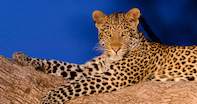
Name
Leopard [Panthera pardus]Appearance
The leopard is the second largest of the big cats in South Africa and is nocturnal predators. Leopards have a yellow-golden coat littered with dark black spots arranged in rosettes all over the body. Their limbs and head area contain single black spots, while their tails are white-tipped underneath. Their head and body length is 1,6 - 2,1m and the tail is 0,68-1 m.
Females are smaller and weigh 17-60 kg whereas males weigh 20-90 kg. Their standing height is 700-800 mm at the shoulders. They are larger and are have more muscular build than the cheetah.
Leopard Diet
The leopard has a varied and flexible diet that allows it to adapt to just about any environment in South Africa. They mainly feed on small antelope, but their diet extends to hyrax, monkeys, fox, fish and reptiles found in South Africa. There have been accounts of leopards living off insects and rodents when regular food sources are scarce. Leopards are also known to be able to live on the outskirts of rural towns and villages.Leopard Breeding
The leopard is a non-seasonal breeder and produces young throughout the year in South Africa. The female will give birth to a litter of two or three cubs after a gestation period of three and a half months.
Cubs are hidden in thick bushes or holes, as the mother goes to great lengths to hide her young from predators. Predators in South Africa such as the lion, cheetah, and hyena often prey on young leopard cubs in the bush. Cubs become independent at one years old, after learning how to survive in the wild from their mothers.
Leopard Behaviour
As the leopard is nocturnal, they can be found sleeping throughout the heat of the day in South Africa. However, daytime hunting for the leopard is not uncommon in certain regions. The main hunting technique of the leopard is to stalk and pounce, then to hold a bite to the throat to asphyxiate prey to death.
Smaller prey are killed with a bite to the back of the neck to break its spinal cord. The leopard will pluck the hair and fur off the carcass before feeding on it. The remains and entrails are hidden under grass and sand. The leopard is an excellent climber, and will drag its catch up into the trees to protect it from other predators.
Leopards are very territorial and males will defend large territories which include those of females. The female leopard also defends her territories from other females.
Leopard Habitat
The leopard can inhabit a variety of environments and climatic conditions around South Africa. They are found along the coastal regions to high up in the mountains with an elevation of 2000 m above sea level.
They inhabit forests, deserts, semi-deserts, bushveld, mountains, woodlands and rocky areas in South Africa. These stealthy animals need environments that offer cover among bushes and rocks. Even though their populations have declined over the years, they can still be found in the wild except in the central regions of South Africa where most farming takes place.
Where Leopards are Found
The leopard can be found throughout South Africa in the many game reserves and national parks in most provinces. These include the well known Kruger National Park and Sabi Sand Game Reserve. Best place to see Leopards
 Leopards are powerfully built animals with strong necks and large skulls and jaws for executing kills....
Leopards are powerfully built animals with strong necks and large skulls and jaws for executing kills.... Leopards have intricate patterning all over their bodies. This pattern is unique to each animal....
Leopards have intricate patterning all over their bodies. This pattern is unique to each animal.... Leopards are extremely flexible and adaptable animals living an elusive and secretive life in myriad habitats and feeding on whatever is mos...
Leopards are extremely flexible and adaptable animals living an elusive and secretive life in myriad habitats and feeding on whatever is mos... Leopards are solitary animals except at times when females may be accompanied by their growing cubs....
Leopards are solitary animals except at times when females may be accompanied by their growing cubs.... A leopard’s vision is excellent and used to locate prey. Forward facing eyes provide the binocular vision necessary for gauging depth and ...
A leopard’s vision is excellent and used to locate prey. Forward facing eyes provide the binocular vision necessary for gauging depth and ... Leopards have excellent senses and they use a combination of these to locate prey....
Leopards have excellent senses and they use a combination of these to locate prey....